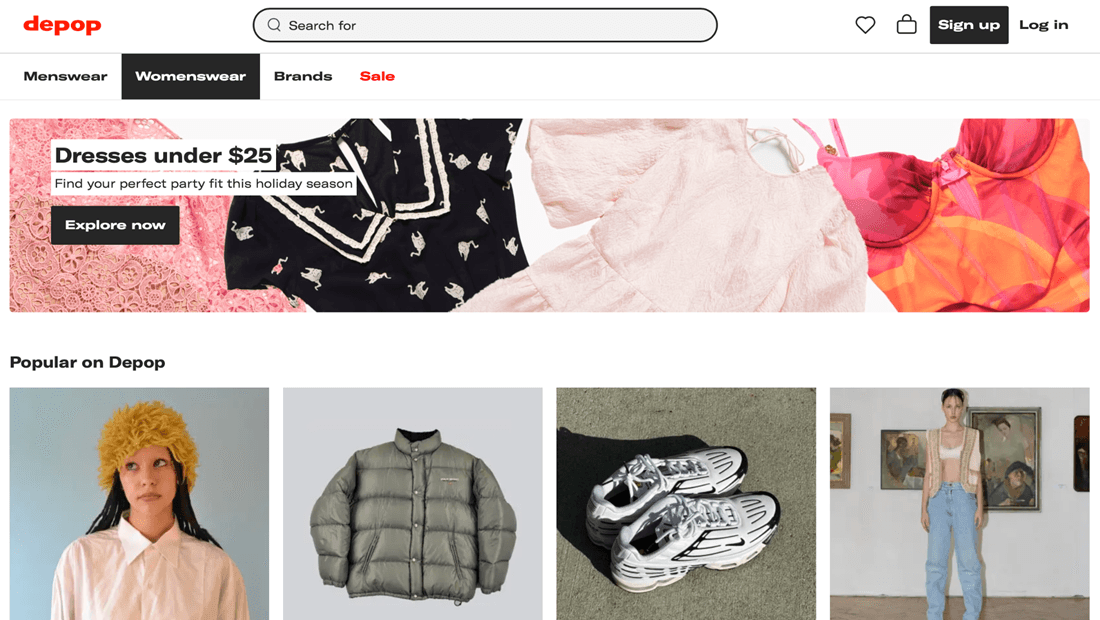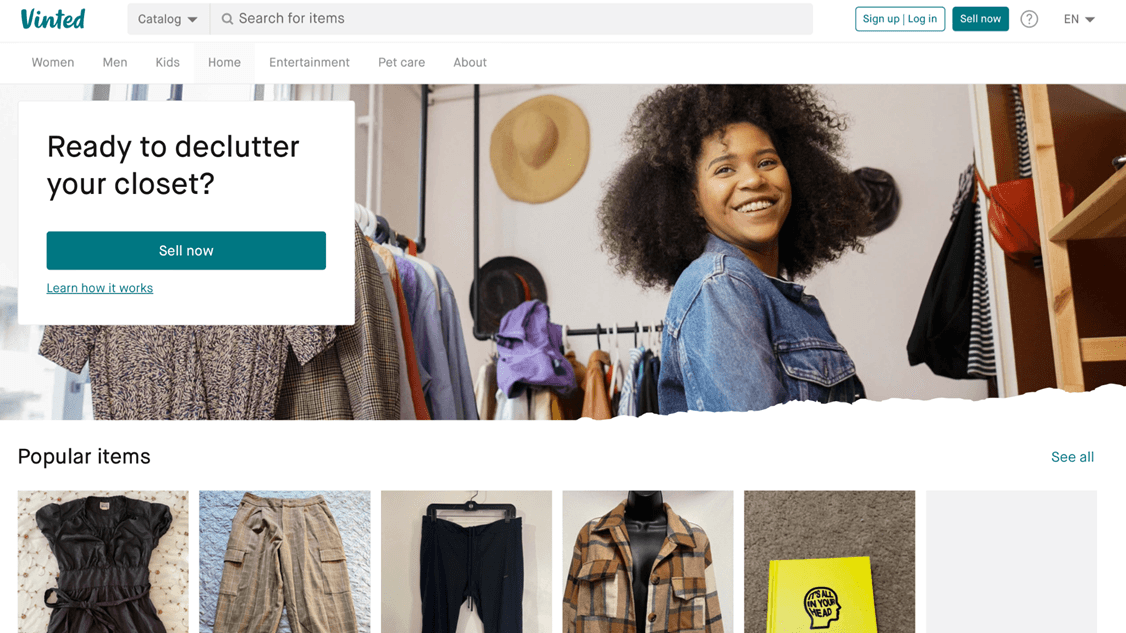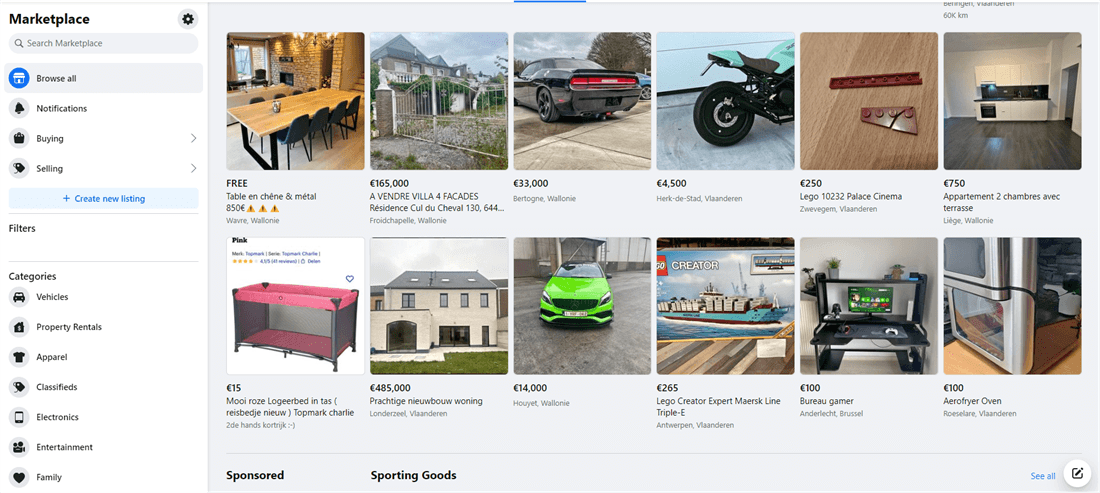6 Reseller Sites Like Poshmark

Let’s be real: everyone and their grandma knows about Poshmark. It’s the go-to app for spring cleaning your closet or scoring some trendy pieces. But Poshmark isn’t the only player in town. There’s a whole world of reselling platforms out there to be discovered, each with its quirks and charms.
We’re diving into six alternatives that give Poshmark a run for its money (and can line your pockets with more!). Whether you’re a fashion guru, a casual declutterer, or just in it for the hustle, there’s a platform for you.
By the end of this guide, you’ll be armed with all the insider info you need to dominate the reselling game.
1. Grailed
Grailed is not your average Joe resale platform. It is a treasure trove for fashionable men looking to find high-end labels and rare pieces at a steal. Launched in 2014, Grailed quickly carved out its niche as a go-to spot for men who know their Raf Simons from their Rick Owens.
It quickly became a community for fashion-forward men and grew in popularity so much that the company eventually expanded to include Womenswear.

Target market
Grailed is the promised land for the fashion-conscious guy. It’s where style enthusiasts who speak the language of streetwear and designer labels converge. Grailed is where your clothes can find their true admirers if your closet screams ‘unique’ or high-end men’s fashion.
Best features for sellers
The curated experience is what makes Grailed stand out. The platform also boasts features like PayPal integration for secure transactions and a feedback system that builds trust. Plus, the ‘Price Drop’ feature is a nifty way to attract buyers to your listings when you need to sell an item fast.
Fees
Grailed takes a slice of the pie, but it’s straightforward about it. They charge a 9% commission on each order. In the grand scheme of things, it’s a small price to pay for access to a dedicated and discerning market.
You can calculate your seller fees with our Grailed fee calculator.
Pros and cons
The pros? You’ve got a captive audience that appreciates quality and rarity. Your Supreme hoodie or limited-edition sneakers won’t go unnoticed here. The downside? The niche market means it’s not for everyone. If you’re dealing in general fashion and hand-me-downs, you might not get much traction on Grailed.
Grailed is the under-the-radar champion for men’s fashion reselling. It’s a platform that understands that sometimes an outfit isn’t just clothes; it’s a statement. If that resonates with you, then Grailed might just be your reselling soulmate.
2. Mercari
Mercari is Japan’s answer to the cluttered world of online resale. Since its inception in 2013, Mercari has made a global splash and become a formidable player in the reselling game for sellers in the USA and Japan.
It’s the jack-of-all-trades in the reselling market, offering everything from vintage tees to tech gadgets and trading cards.

Target market
Mercari casts a wide net. It’s perfect for the everyday seller looking to declutter or the side hustler flipping goods for profit. This platform doesn’t cater to one specific niche, which makes it a versatile choice for a diverse range of sellers.
Best features for sellers
Selling on Mercari is as easy as snapping a photo, setting a price, and waiting for buyers to bite. The app is user-friendly, and its shipping process is streamlined for convenience.
Everything is done through the platform, so there’s no need for awkward meet-ups, ensuring a hassle-free experience for all.
Fees
Mercari takes a flat 10% commission on all sales, which is pretty standard in the reselling world. In April 2023, they introduced a payment processing fee similar to Etsy with a 2.9% + $0.50 charge per sale.
You can calculate your seller fees with our Mercari fee calculator.
Pros and cons
Mercari’s biggest draw is that it is incredibly user-friendly. It’s easy to list items, and the platform’s broad audience means your stuff has a good chance of selling.
However, the downside is the sheer variety of listings can sometimes mean your items get lost in the crowd. Plus, due to the diverse marketplace, you might not always fetch top dollar for high-value items.
Mercari is versatile, straightforward, and handy for a variety of needs. Mercari’s simplicity and broad appeal make it a solid choice whether clearing out your garage or running a small business.
3. Depop
Depop swooped into the fashion world by putting a fresh twist on online selling. It was one of the first sites like Poshmark to blend social media and e-commerce. Since its launch in 2011, it’s become synonymous with trendy, vintage items that showcase a person’s individuality.

Target market
Depop is the stomping ground for the young and the fashion-forward. It’s where Gen Z and millennials flock to find unique pieces that show off unique personalities. If you’ve got an eye for the next big trend or a closet full of vintage gems, Depop is your runway.
Best features for sellers
Depop’s strength lies in its social media-like interface. Sellers curate their own shop, akin to an Instagram profile, making it as much about building a brand as it is about selling. Following, liking, and sharing features create an engaging and community-driven experience.
Fees
Depop keeps it simple when it comes to fees. They charge a 10% fee on the total transaction amount, including shipping. It’s a straightforward cut with no hidden surprises.
You can calculate your seller fees with our Depop fee calculator.
Pros and cons
The major pro of Depop is its vibrant, engaged community. It’s a platform that thrives on personality and connection, making it ideal for sellers with a unique style or story to tell.
However, the flip side is the competition. With so many sellers vying for attention, standing out requires more than just great products – it demands a knack for branding and social engagement.
Depop is a melting pot of fashion, culture, and social networking. It’s where the cool kids sell their wardrobes and where savvy buyers go to snag a piece of the cake. If that sounds like your scene, Depop might just be your perfect match.
4. Vinted
Vinted is a bit like that cozy thrift store down the street but in the digital space. It started in 2008 as a Lithuanian startup and has since blossomed into a global community. Vinted’s charm lies in its focus on second-hand clothing with a drive to make sustainable fashion more accessible and affordable.

Target market
Vinted’s appeal is broad but especially resonates with budget-conscious fashionistas and eco-friendly consumers. If you’re into recycling styles and keeping clothes out of landfills, Vinted is your virtual playground. It’s ideal for anyone who wants to give their pre-loved clothes a second chance at life.
Best features for sellers
Vinted stands out with its no-fee policy for sellers. That’s right – you keep all the profits. The platform is also user-friendly, with a simple listing process and a feature to swap items instead of selling, adding a fun twist to the typical reselling experience.
Fees
In a unique move, Vinted charges the buyer a small fee, not the seller. This approach makes it more financially viable to list low-value items or for sellers just starting out.
You can calculate your seller fees with our Vinted fee calculator.
Pros and cons
The no-seller-fee policy is a massive plus, putting more money in your pocket. The platform also fosters a community vibe, making selling more enjoyable.
However, the cons include potentially lower visibility due to a less aggressive marketing approach than bigger platforms. And, while the lack of fees is great for sellers, it can sometimes lead to unrealistic buyer expectations for lower prices.
Vinted is like that friend who always finds a treasure in the bargain bin. It’s a platform that celebrates the cycle of fashion without breaking the bank. For the thrifty seller who’s also eco-conscious, Vinted could be your new best friend in the reselling game.
5. eBay
eBay is the OG online marketplace. It started as a quirky auction site for collectibles and books in 1995 and grew into the e-commerce giant we know today, where almost anything can be bought and sold. eBay’s appeal is its diversity – it’s as much a place for rare collectibles as everyday items.

Target market
eBay’s target market is as varied as its product range. It’s a hub for collectors, bargain hunters, and regular folks looking to buy or sell just about anything. eBay’s platform accommodates a broad spectrum of sellers, whether you’re offloading an old smartphone or auctioning a rare vintage dress.
Best features for sellers
One of eBay’s standout features is its auction format, which offers sellers the chance to get the best price for their items. The ‘Buy It Now’ option also caters to those looking for a quick sale. eBay’s global reach means your listings can attract buyers from all over the world, which significantly broadens your market.
Fees
eBay charges a listing fee and a final value fee, which is a percentage of the sale price. These fees vary depending on the item category and selling price. While the fee structure can be more complex than other platforms, the potential reach and selling price can make it worthwhile.
Pros and cons
The massive audience is eBay’s biggest flex, which offers unparalleled exposure for your listings. The platform is also highly flexible in catering to casual and professional sellers alike.
The downside? The sheer size of eBay can make it challenging to stand out, and the fee structure can be off-putting for smaller sellers.
eBay is versatile, dependable, and capable of fitting almost any selling need. For sellers looking to reach a global audience with a mix of auction and direct sales, eBay remains a top contender.
6. Facebook Marketplace
Facebook Marketplace is the new kid on the block in the online selling space, but it’s backed by the social media giant’s massive reach. Facebook Marketplace was launched in 2016 and leverages Meta’s network to connect local buyers and sellers.
It’s like your neighborhood yard sale gone digital, making transactions personal and community-focused.

Target market
The target market for Facebook Marketplace is vast and varied, thanks to Facebook’s extensive user base. It’s ideal for individuals looking to sell or buy within their local community. The platform caters to a wide range of casual sellers and buyers, from furniture and home goods to clothes and electronics.
Best features for sellers
The biggest draw of Facebook Marketplace is its integration with your profile, adding trust and transparency to transactions. The local focus eliminates shipping hassles and makes it easier to arrange pickups and drop-offs. Plus, reaching a large local audience without needing a separate app or account is convenient.
Fees
One of Facebook Marketplace’s biggest perks is the lack of fees for most transactions. This no-fee approach makes it highly attractive for casual sellers and those looking to offload items quickly without worrying about costs.
You can calculate your seller fees with our Facebook Marketplace fee calculator.
Pros and cons
The main advantage of Facebook Marketplace is its ease of use and its integration with your existing social network. This can lead to quicker sales and a more straightforward selling experience.
However, the downside is the lack of a structured buyer protection system, which can be a concern for both buyers and sellers. Also, the informal nature of the platform might not suit sellers looking for a more professional selling environment.
Wrapping up
While Poshmark is incredibly well-known and a great platform to launch a reselling business, there are many more sites like Poshmark where you can amplify your efforts. Sellers must spread their wings across multiple platforms using a multi-channel selling strategy.
This approach maximizes visibility and increases the chances of a sale by tapping into the diverse user bases of different marketplaces. However, managing listings across several platforms can be a time-consuming task.
However, tools like Crosslist are a game-changer for multi-channel sellers. Crosslist allows sellers to create and manage their listings on various marketplaces like eBay, Mercari, and others, all from a single interface.
In addition to that, you may also want to consider tools such as utilizing a custom email template to enhance communication and engagement with interested buyers.
This not only saves time but also ensures consistency across platforms. With such tools, sellers can easily expand their reach without getting bogged down in the minutiae of individual platform listings.
Whether you’re a casual seller or a reselling pro, embracing multi-channel selling with tools like Crosslist can transform the way you do business in the digital realm.
Questions or just say hello!
Well, congratulations to you for making it this far! Here’s a reward in the form of a 10% discount code on your first month of Crosslist (add during check-out). Sign up now with a 3-day money-back guarantee!
10% off
BLOG10
You can learn more about how Crosslist works here.
If you have further questions, feedback, bug reports, or want to know a bit more about us, why not swing by for a chat and say G’day! You can have a chat with us through Messenger.
